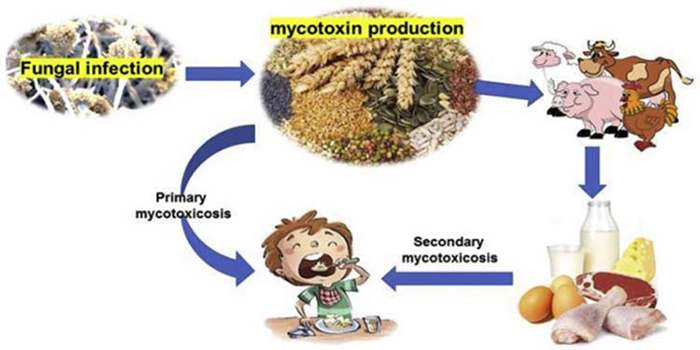JK News Today

Mycotoxins are secondary metabolites produced by fungi and are capable of causing various diseases in humans and animals. They are naturally occurring chemical substances and are chemically stable which is why they pose a great threat to public health. Accumulation of mycotoxins in the food chain can cause hazardous effects in human. The gut microbiota has a bidirectional relationship with mycotoxin, being the leading cause of the development of mycotoxicosis. Preventive measure for controlling contamination should be adopted both before and after harvest.
INTRODUCTION
Mycotoxins are naturally occurring, low molecular weight, chemically stable secondary metabolites produced by fungi like Aspergillus, Fusarium, Penicillium species and are the cause of adverse health effects in humans and animals, leading to mycotoxicosis. They grow on various crops including cereals, nuts, spices and coffee beans, apples under warm and humid conditions. Mycotoxins are exotoxins that are produced when fungal growth ceases due to nutrient limitations and the presence of excess carbon source. Occurrence of mycotoxins in food poses great threat to the consumers and is considered to be one of the major global health issue.
COMMON TYPES OF MYCOTOXINS
There are a number of mycotoxins identified so far, some of them have gained attention due to their severe health effects and occurrence in food. These includes Aflatoxins, Ochtratoxin A and Patulin. Aflatoxins are one of the most deadly mycotoxins produced by Aspergillus flavus and Aspergillus parasiticus. They affect cereals like sorghum, wheat, rice nuts like almond, pistachio, coconut and spices including turmeric, ginger, pepper, and coriander. They are genotoxic and large doses can damage liver and cause aflatoxicosis. Aspergillus and Penicillium sps produces Ochtratosin A in cereals, coffee beans, grape juice. One of the most notable effect is kidney damage and also has an effect of fetal immune system. Patulin are commonly found in rotting apples and apple products. In humans it causes vomiting, gastrointestinal diseases, nausea and it also has high potential of being carcinogenic.
IMPACT OF MYCOTOXIN ON HUMAN HEALTH
Mycotoxin has been associated with a variety of acute and chronic human diseases. Mycotoxin can occur in food and agricultural products via contamination at any stage of processing, packaging, transport, production and storage. Intake of low levels of mycotoxin over a long period of time causes kidney and liver impairment, whereas exposure to high dose mycotoxin leads to abdominal pain, diarrhea and chronic intoxication. Aflatoxins is amongst one of the potent mycotoxins. It is associated with human diseases including liver cancer, Reye’s syndrome, chronic gastritis, Kwashiorkor and respiratory diseases in various parts of the world. Fusarium toxins plays a major role in the onset of diseases such as Kashin Beck syndrome, Mseleni joint disease and oesophageal tumours.
SIGNIFICANCE OF MYCOTOXIN IN FOOD INDUSTRY
In addition to risking public health, mycotoxins also generates huge economic loss in food industry. Ergotism is one of the oldest mycotoxin related disease in humans caused by consuming ergot body in rye infected by the fungus Claviceps sp. The first outbreak of mycotoxin occurred in England where almost 100,000 turkeys died due to the consumption of peanut meal imported from Brazil contaminated with aflatoxins. Mycotoxins first affected humans in 1960, and still persists worldwide. It appears in almost all animal feed like wheat bran, maize grain, milk, meat and human food like cereals, nuts and spices. Mycotoxin contamination in food and fodder is becoming a global concern each day. According to reports by Food and Agricultural Organisation (FAO), nearly 25% of world’s crops are being affected by mycotoxin leading to huge economic loss, low product yield, decrease in commercial value of food and loss of human and animal health. Many mycotoxins are known to survive processing into flour and meals and are not easily detectable. Such “hidden” mycotoxin can pose a significant hazard to human health.
MYCOTOXIN AND GUT HEALTH
The role of mycotoxin towards gut health and microbiota has been comprehensively discussed. Existence of a bi directional relationship is noted between mycotoxins and gut microbes, whereby they are involved in the development of mycotoxicosis. It is well established that healthy gut microbiota plays a significant role in the overall health of an individual. A person with healthy and balanced gut microbiota has the capability to eliminate mycotoxicosis naturally from the host. Till date, there are various approaches to maintain a healthy gut microbiota, apart from several other benefits it also protects the host from the toxicity of mycotoxins. The gastrointestinal tract is responsible for food ingestion, digestion, elimination of waste products and nutrient absorption. The GI tract acts as a filter against harmful mycotoxins. When a person intakes contaminated food, mycotoxins can alter normal intestinal morphology and functions, thus, leading to change in the diversity of gut microbiota.
ROLE IN BIOTERRORISM
The abuse of mycotoxins as a biological weapon is not only theory based as there are evidence to prove the use of aflatoxins as a part of Iraqi biowarfare programme during the 1980’s. It is preferred over other chemical warfare agents as there are no real time detection or any alarming signs of fire, blast and they are highly stable capable of causing potent acute toxicity. Some researchers say mycotoxins are impractical biological weapon, as large amount of pure mycotoxin is required to be effective. On the contrary, fungal weapon do not require any elaborate facilities for its growth, purification of toxins or any trained personnel. Poisoning of crops in field via mycotoxins would be ineffective, therefore it’s dispersion in a public places might be a method of choice for bioterrorism attacks, as the entire population would be exposed.
CONCLUSION
Mycotoxins are poisonous, naturally occurring chemical compounds produced by fungi under favourable conditions. Almost 25% of the world’s crops are contaminated by molds and fungal growth. Their toxicity not only leads to adverse animal and human health affects but also cause major environmental changes. Although, the extent of its toxicity depends upon several factors like period of exposure, type of mycotoxin, nutritional value, still it’s harmful effects cannot be overlooked. Control of contamination by mycotoxin should be one of the foremost approaches in order to maintain public health and improve economic condition of the countries.
‘Any error in this manuscript is silent testimony of the fact that it was a human effort’
Dr. Wahied Khawar Balwan
Sr. Asstt. Professor & Head
Department of Zoology
Govt. Degree College Kilhotran,
Doda, Jammu & Kashmir
E-mail: wahied_kb@yahoo.co.in





